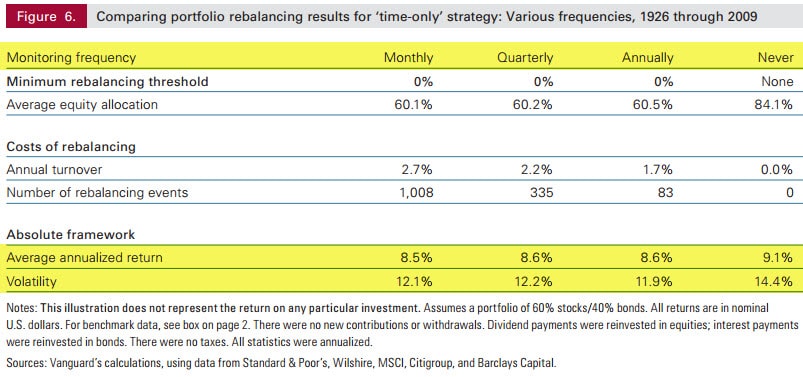Everything in life that surrounds you requires maintenance. This includes your home, your automobile, the software application on your mobile device, and even your health.
Unfortunately, your job for maintaining stuff doesn’t stop there. Why? Because your investments – whether they are held in taxable accounts or tax-deferred retirement accounts like IRAs, 401(k), and 403(b) plans – should likewise be monitored and kept up-to-date.
One such form of financial maintenance is something called “portfolio rebalancing.” How does it work? You simply buy or sell assets inside your investment portfolio with the purpose of sticking to a specific or target asset allocation that matches up with your goals.
Before determining whether rebalancing is something you should do, let’s first examine several different rebalancing strategies.
“Time-based” Strategies
The “time-based” strategy makes adjustments to your investments based upon a prescribed time period.
For instance, rebalancing your portfolio daily, monthly, quarterly, or annually are all examples of time-based strategies. Remember: Time – not market conditions or your risk capacity – is the only factor involved with time-based rebalancing strategies.
Pros: Time-based strategies keep your portfolio rebalancing schedule on a rigid and disciplined schedule.
Cons: Frequent rebalancing with time-based strategies – especially daily, monthly, and quarterly rebalancing – can trigger taxes and brokerage transaction costs, which will be a drag on long-term performance returns. Also, since time-based strategies completely ignore market conditions, a time-based rebalancing strategy may cause an investor to buy and sell portfolio assets at the wrong price and wrong time.
“Threshold-based” Strategies
Investors that use threshold-based rebalancing strategies are focused on how their portfolio’s asset mix has drifted from its target asset mix by a determined level of 1%, 5%, 10%, or some other percentage amount. Let’s analyze an example.
For simplicity, let’s assume a certain investor has a target asset mix of 50% stocks and 50% bonds with a rebalancing threshold of 10%. If the stock position inside the portfolio ever exceeded the 10% threshold on either the upside or downside, it would trigger an automatic rebalancing event that would return the portfolio back to the investor’s original or target asset commitment of 50% exposure to stocks.
Pros: Threshold-based rebalancing strategies keep your portfolio disciplined and closely tied to your original or target asset allocation.
Cons: The taxes and brokerage transaction costs of threshold rebalancing can add up quickly, especially with really super tight thresholds of 20% or less.
“Tactical-based” Strategies
The tactical based strategy for rebalancing is generally governed by market conditions or other factors like securities prices and valuations.
For example, if the valuation of a major asset class like stocks (NYSEARCA:VT) or real estate (NYSEARCA:RWR) were to rise beyond a certain level, a tactical rebalancing strategy might reduce or completely eliminate exposure to that particular overvalued asset class in favor of cash or another alternative. Conversely, if the valuation of a certain asset class were to dip below certain thesholds, a tactical-based rebalancing strategy would opportunistically rotate money into the depressed value of that particular asset.
While a small minority of individual investors use tactical rebalancing strategies, it’s far more common among hedge funds, especially quantitative driven funds. “Quant” funds, as they’re also called, employ a variety of sophisticated metrics and systems along with algorithms that tactically determine a portfolio’s optimal asset mix.
Pros: Tactical-based rebalancing can take advantage of distortions in the price and valuation of securities that inevitably happen.
Cons: When the timing or programmed algorithms of tactical-based rebalancing is inaccurate, it can damage the portfolio’s performance.
“No-Rebalancing” Strategies
The final rebalancing strategy is to never rebalance the holdings within your portfolio at all! It’s the ultimate do-nothing zero maintenance approach. And while it may seem like the worst rebalancing choice compared to others, the results say otherwise.
An 83-year study by Vanguard from 1926 to 2009 showed that a never rebalanced portfolio outperformed time-based rebalancing strategies (monthly, quarterly, and annually) by one-half percent. But the trade-off for the better returns of never rebalancing was higher portfolio volatility. Although a no-rebalancing approach might sound appealing, few investors have the risk appetite to stick with the approach, particularly during deep market corrections.
Pros: Never rebalancing your portfolio has zero tax implications and zero trading costs. It also allows your winning investments to grow without interruption.
Cons: Never rebalancing your portfolio increases the volatility of your investments and may cost you many sleepless nights if you’re prone to emotional mood swings caused by gyrating financial markets. Also, you will likely get stuck with investments that suffer deep and unrecoverable losses.
Summary
Rebalancing is a personal decision that each investor should make after they’ve carefully considered the choices. And the four rebalancing strategies covered here, should provide you with enough ideas on how to make your investment portfolio an optimal performer that aligns with your goals.




